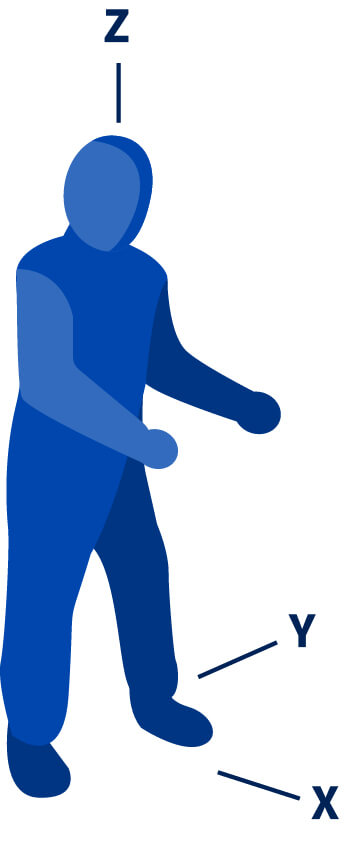Main Menu
- Home
- Products
- Applications
- Product Support
- Service
- Learn
- Product News
- About Us
- Contact Us
Every day, human beings interact with some sort of machinery, making contact with vibration inevitable. Unfortunately, continuous exposure to mechanical vibration can lead to serious injury.
Understanding Whole-Body Vibration
Whole-body vibration (WBV) is the vibration transmitted through the seat or feet of a worker while operating machinery or standing on vibrating platforms. Some work environments where WBV is of concern include mining, farming, construction, trucking, sailors, helicopter pilots, and industrial equipment.
Health Concerns from WBV
Determining Whole-Body Vibration Risk
Some questions that can be used determine if further action may be required:
When further action is needed, there are two ways with which human vibration exposure can be determined. The first is to use tables of predetermined machine vibration levels combined with measured exposure times to estimate a total exposure. The second method is to measure the exposure using an instrument designed for this purpose such as the Larson Davis Human Vibration Meter Model HVM200.
Measuring
WBV Exposure
Daily vibration exposure is dependent upon the magnitude of the vibration to which the worker is exposed and the duration of the exposure. Whole-body vibration levels are measured using a specially designed sensor (SEN027)
which is a triaxial accelerometer built into a flexible disk that can be stood or sat upon.
This sensor is connected to a meter like the HVM200 which implements the required frequency weighting filters and produces the results of the measurement. There are a variety of weightings used to measure whole body vibration - a short guide offers insight into when each should be used.
Whole-Body Vibration Exposure Limits
The European Union has set exposure limits in directive 2002/44/EC and the ACGIH has set limit values that follow the ISO 2631-1 standard for WBV. These "action" and "limit"
values are shown below for reference.
| Standard | Limit Values (likely health risk) | Action Values (caution) |
| ACGIH ISO 2631-1 | A(8) = 0.9 m/s2 VDV = 17 m/s1.75 | A(8) = 0.5 m/s2 VDV = 8.5 m/s1.75 |
| EU Directive 2002/44/EC | A(8) = 1.15 m/s2 VDV = 21 m/s1.75 | A(8) = 0.5 m/s2 VDV = 9.1 m/s1.75 |
What You Can Do to Protect Workers
By implementing a program to routinely measure the exposure of at-risk employees, companies can substantially reduce their risk for expensive work induced injuries. With the help of the Larson Davis HVM200 Human Vibration Meter you can implement a program to assess, mitigate and monitor risk by following the best practices outlined by the American Conference of Governmental Industrial Hygienists (ACGIH) and documented in ISO 2631-1, Evaluation of Human Exposure to Whole-body Vibration. Alternatively the European Union has issued Directive 2002-22-EC to specify an employer's obligations with respect to determining, assessing, and mitigating risk. Effective programs should include these elements:
Calculating Daily Exposure Metric
 Vibration exposure can be assessed using metrics that are
calculated and displayed by the HVM200.
Vibration exposure can be assessed using metrics that are
calculated and displayed by the HVM200.
The Daily Vibration Exposure A(8) is calculated from the frequency weighted r.m.s acceleration measurements awx, awy, and awz and the measured exposure period Texp. The highest value of A(8)x, A(8)y, or A(8)z is the Daily Vibration Exposure, A(8).
The Vibration Dose Value (VDV) provides an alternative evaluation of vibration exposure that is often used to give a better indication of the risks associated with "shock" or "peak" events. The VDV is a cumulative value that increases with measurement time. The highest value of VDVexp,x, VDVexp,y, or VDVexp,z is the Vibration Dose Value, VDV.
In the News
Standards, Regulations & Directives
| Standard | Description |
| ISO 8041:2005 | Standard for instruments measuring human response to vibration |
| ISO 2631-1:1997 | General requirements for measuring whole-body vibration |
| ISO 2631-2:2003 | Vibration in buildings |
| ISO 2631-4:2001 | Vibration of passengers and crew in fixed guideway systems such as rail |
| ISO 2631-5:2004 | Evaluation of vibration containing multiple shocks |
| ISO 6954:2000 | Vibration on ships with regard to habitability |
| ISO 7096:2000 | Evaluation of earth moving machinery seat vibration |
| ISO 10326-1:1992 | Basic requirements for vehicle seat vibration |
| ISO 10326-2:2001 | Laboratory method for determine rail seat vibration |
For more information about whole-body vibration see the EU Good Practice Guide or Safe Work Australia Guide.